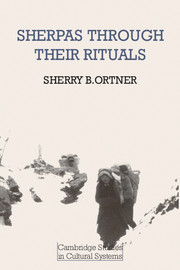Book contents
- Frontmatter
- Contents
- Preface
- 1 Introduction: some notes on ritual
- 2 The surface contours of the Sherpa world
- 3 Nyungne: problems of marriage, family, and asceticism
- 4 Hospitality: problems of exchange, status, and authority
- 5 Exorcisms: problems of wealth, pollution, and reincarnation
- 6 Offering rituals: problems of religion, anger, and social cooperation
- 7 Conclusions: Buddhism and society
- Notes
- Bibliography
- Index
3 - Nyungne: problems of marriage, family, and asceticism
Published online by Cambridge University Press: 05 June 2012
- Frontmatter
- Contents
- Preface
- 1 Introduction: some notes on ritual
- 2 The surface contours of the Sherpa world
- 3 Nyungne: problems of marriage, family, and asceticism
- 4 Hospitality: problems of exchange, status, and authority
- 5 Exorcisms: problems of wealth, pollution, and reincarnation
- 6 Offering rituals: problems of religion, anger, and social cooperation
- 7 Conclusions: Buddhism and society
- Notes
- Bibliography
- Index
Summary
The most striking aspect of orthodox Buddhism is its ascetic ideology, and the monastic tradition built around this ideology. Among the Sherpas, only about 2 percent of the men are under active monastic vows, and the entire lay population is by definition failing to live up to the highest ascetic ideal of celibacy. But these points give no indication of the degree to which the ascetic ideal nonetheless weaves through the lives and institutions of the Sherpa people. For much of life takes place as it were in counterpoint to this ideal, and occasionally in direct conflict with it.
There are, however, opportunities to enact (a version of) the ascetic ideal within lay life. Once a year, in the late spring, there is a four-day holiday called Nyungne, during which individuals may practice certain acts and renunciations, becoming “like monks” for the period of the holiday. There is a second, less stressed observance of a similar nature about six months later. And pious lay people may also spend a day fasting and performing religious actions on the full-moon and no-moon days of each month. In all cases the point is to approximate the ideal of asceticism and to gain religious merit toward a good rebirth.
The key vow of Buddhist ascetism, and the symbol of all the other renunciations of “the world,” is celibacy, abstention from sexual relations.
- Type
- Chapter
- Information
- Sherpas through their Rituals , pp. 33 - 60Publisher: Cambridge University PressPrint publication year: 1978

